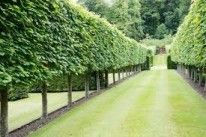Pleaching is an ancient horticultural practice that involves training and shaping trees into a specific pattern to create living archways, hedges, or screens. The technique typically employs deciduous or evergreen trees with pliable branches, such as hornbeam (Carpinus betulus), lime (Tilia cordata), beech (Fagus sylvatica), or fruit trees like apple (Malus) and pear (Pyrus). Through careful pruning and manipulation, the branches are woven or tied together to form a horizontal framework, while the foliage above creates a lush, dense canopy.
In the world of landscape design, pleached trees have emerged as a timeless and sophisticated feature that seamlessly combines nature with artistry. With origins dating back to medieval times, pleached trees have captivated gardeners and designers for centuries. Their structured and formal appearance, along with the ability to create beautiful living screens, make them a perfect choice for contemporary landscapes seeking a touch of classic elegance. In this article, we will delve into the art of pleaching, its historical significance, and its modern applications, highlighting why pleached trees continue to hold their allure in today's garden design.
1. Understanding Pleached Trees
Pleaching is an ancient horticultural practice that involves training and shaping trees into a specific pattern to create living archways, hedges, or screens. The technique typically employs deciduous or evergreen trees with pliable branches, such as hornbeam (Carpinus betulus), lime (Tilia cordata), beech (Fagus sylvatica), or fruit trees like apple (Malus) and pear (Pyrus). Through careful pruning and manipulation, the branches are woven or tied together to form a horizontal framework, while the foliage above creates a lush, dense canopy.
2. The Historical Significance of Pleached Trees
Pleached trees have a rich history that can be traced back to medieval gardens and the Renaissance era. They were particularly popular in formal gardens of French chateaus and Italian villas during the 17th and 18th centuries. These carefully trained trees were not merely decorative but also served functional purposes, like providing shade and privacy while maintaining the formal aesthetics of the landscape. The skill of pleaching was passed down through generations of gardeners, and today, its heritage is preserved by contemporary landscape designers who admire the art form.
3. Modern Applications
Despite originating in the past, pleached trees have found renewed popularity in modern landscapes. Their structured elegance and ability to fit seamlessly into various garden styles have made them a sought-after feature in urban and suburban settings alike. Some common applications include:
-
Privacy Screens: Pleached trees can be used to create natural barriers that offer both privacy and beauty. They are an excellent alternative to traditional fences or walls, allowing for a softer and more organic touch to the landscape.
-
Avenues and Walkways: Aligned in rows, pleached trees can form captivating avenues or walkways, guiding visitors through the garden while adding a touch of grandeur.
-
Dividers and Boundaries: When employed as dividers, pleached trees can elegantly separate different sections of the garden or define property boundaries.
-
Architectural Elements: Pleached trees can be used against walls or buildings to create a living tapestry, adding depth and visual interest to otherwise flat surfaces.
-
Small Gardens: For those with limited space, pleached trees offer a vertical element without taking up a significant footprint, making them ideal for smaller gardens or even urban rooftop settings.
4. The Art of Pruning
One of the essential aspects of pleached trees is the careful and consistent pruning required to maintain their distinct shape. Regular pruning not only helps retain the formal appearance but also ensures proper airflow and sunlight penetration, promoting healthy growth. Gardeners must prune during the dormant season to minimize stress on the trees and avoid interfering with new growth.
Conclusion
Pleached trees are a living testament to the enduring allure of classical gardening practices. Their elegant form, historical significance, and adaptability to modern landscapes make them a valuable addition to any garden design. By incorporating pleached trees, gardeners and designers can achieve an unparalleled fusion of natural beauty and structured artistry, transforming ordinary spaces into timeless, harmonious retreats.
This article is provided by https://www.provendernurseries.co.uk/plants/trees1/pleached-trees1









*********3@godsigma.com
That is the excellent mindset, nonetheless is just not help to make every sence whatsoever preaching about that mather. Virtually any method many thanks in addition to i had endeavor to promote your own article in to delicius nevertheless it is apparently a dilemma using your information sites can you please recheck the idea. thanks once more. 香港新聞